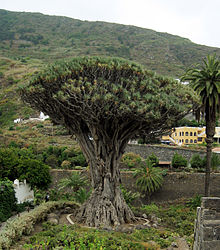Dracaena draco
| Dracaena draco | |
|---|---|
 |
|
| The ancient specimen at Icod de los Vinos, Tenerife | |
| Scientific classification | |
| Kingdom: | Plantae |
| Clade: | Angiosperms |
| Clade: | Monocots |
| Order: | Asparagales |
| Family: | Asparagaceae |
| Subfamily: | Nolinoideae |
| Genus: | Dracaena |
| Species: | D. draco |
| Binomial name | |
|
Dracaena draco (L.) L. |
|
| Synonyms | |
|
|
Not to be confused with the related Dracaena cinnabari, the dragon blood tree native to Socotra (an island near Yemen).
Dracaena draco, the Canary Islands dragon tree or drago, is a subtropical tree-like plant in the genus Dracaena, native to the Canary Islands, Cape Verde, Madeira, and locally in western Morocco, and introduced to the Azores. It is the natural symbol of the island of Tenerife, together with the blue chaffinch.
Dracaena draco is a monocot with a tree-like growth habit currently placed in the asparagus family (Asparagaceae, subfamily Nolinoidae). When young it has a single stem. At about 10–15 years of age the stem stops growing and produces a first flower spike with white, lily-like perfumed flowers, followed by coral berries. Soon a crown of terminal buds appears and the plant starts branching. Each branch grows for about 10–15 years and re-branches, so a mature plant has an umbrella-like habit. It grows slowly, requiring about ten years to reach 1.2 metres (4 ft) in height but can grow much faster.
Being a monocotyledon, it does not display any annual or growth rings so the age of the tree can only be estimated by the number of branching points before reaching the canopy. The specimen called "El Drago Milenario" (the thousand-year-old dragon) growing at Icod de los Vinos in northwest Tenerife is the oldest living plant of this species. Its age was estimated in 1975 to be around 250 years, with a maximum of 365 years, not several thousand as had previously been claimed. It is also the largest D. draco tree alive. Its massive trunk comes from the contribution of clusters of aerial roots that emerge from the bases of lowest branches and grow down to the soil. Descending along the trunk, they cling tightly to the trunk, integrate with it and contribute to its radial growth. There is considerable genetic variation within the Canary Island dragon trees. The form found on Gran Canaria is now treated as a separate species, Dracaena tamaranae, based on differences in flower structure. The form endemic to La Palma initially branches very low with numerous, nearly vertical branches arranged fastigately. There is a forest of such trees at Las Tricias, Garafia district, La Palma.
...
Wikipedia

